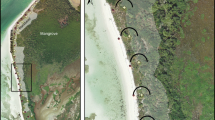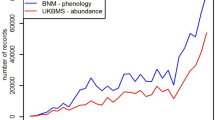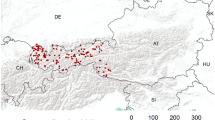Abstract
Multiple transect counts following Butterfly Monitoring Scheme (UKBMS) guidelines and Jolly–Seber estimates of population size were used to monitor the abundance of second generation Lasiommata megera on a single site in southern England. The two methods resulted in different patterns of emergence being detected. The proportion of the population (estimated by Jolly–Seber) recorded with transect counts depended on the time of day and weather with afternoon transect counts best recording the trend in abundance over the flight period, but even then counts recorded a variable fraction of the population (6.2–51.3%). Increasing the frequency with which transect counts are carried out per week reduced variation and increased the fit of transect counts to Jolly–Seber generated population estimates. However, indices of abundance generated from randomly selected transect counts for L. megera within sampling weeks varied 4-fold and indices for other butterfly species were also highly variable. For L. megera, transect count variability is attributed to non-representative placement of the transect route and changes in the behaviour and spatial distribution in relation to population size and season. We suggest that transect counts need to be fully validated before the data are used to monitor changes of butterfly populations at individual sites.



Similar content being viewed by others
References
Asher J, Warren M, Fox R, Harding P, Jeffcoate G, Jeffcoate S (2001) The millennium atlas of butterflies in Britain and Ireland. Oxford University Press, Oxford
Begon M (1979) Investigating animal abundance. Edward Arnold, London
Brown JA, Boyce MS (1998) Line transect sampling of Karner blue butterflies (Lycaeides melissa samuelis). Environ Ecol Stat 5:81–91
Brereton T, Stewart KA and Warren M (2002) Developing a system for assessing the effects of agri-environment schemes on butterfly populations. http://www.butterfly-conservation.org/conbio/mfb/maff/2002_newsletter.pdf
Brereton T, Wigglesworth T, Warren MS and Stewart K (2005) BD1446: agri-environment schemes and butterflies: re-assessing the impacts and improving final delivery of BAP targets. Butterfly Conservation Final Project report, supplied to Defra
Butterfly Conservation (1996) Species action plan: the Mountain ringlet Erebia epiphron. Butterfly Conservation, Wareham, Dorset
Dennis RLH (2004a) Just how important are structural elements as habitat components? Indications from a declining lycaenid butterfly with priority conservation status. J Insect Conserv 8:37–45
Dennis RLH (2004b) Butterfly habitats, broad-scale biotope affiliations, and structural exploitation of vegetation at finer scales: the matrix revisited. Ecol Entomol 29:744–752
Dennis RLH, Bramley MJ (1985) The influence of man and climate on dispersion of patterns within a population of adult Lasiommata megera (L.) (Satyridae) at Brereton Heath, Cheshire (UK). Nota Lep 8: 309–324
Dennis RLH, Shreeve TG, Van Dyck H (2003) Towards a functional resource-based concept for habitat: a butterfly biology viewpoint. Oikos 102:417–426
Dennis RLH, Shreeve TG, Isaac N, Roy DB, Hardy P, Fox R, Asher J (2006) Are butterflies, as an indicator taxon, affected by biased recording? Biol Conserv 128:486–492
Dennis RLH, Sparks TH (2006) When is a habitat not a habitat? Dramatic resource use changes under differing weather conditions for the butterfly Plebejus argus. Biol Conserv 129:291–301
Fox R, Warren MS, Harding PT, McLean IFG, Asher J, Roy DB (2001) The state of Britain’s butterflies. Butterfly conservation, CEH and JNCC, Wareham, Dorset
Krauss J, Steffan-Dewenter I, Muller CB, Tscharntke T (2005) Relative importance of resource quantity, isolation and habitat quality for landscape distribution of a monophagous butterfly. Ecography 28:465–474
Maes D, Ghesquiere A, Logie M, Bonte D (2006) Habitat use and mobility of two threatened coastal dune insects: implications for conservation. J Insect Conserv 10:105–115
New TR (1997) Are Lepidoptera an effective ‘umbrella group’ for biodiversity conservation? J Insect Conserv 1:5–12
Parmesan C, Ryrholme N, Stefanescu C, Hill JK, Thomas CD, Descimon H, Huntley B, Kaila L, Kullberg J, Tammaru T, Tennant J, Thomas JA, Warren M (1999) Polewards shifts in geographical ranges of butterfly species associated with regional warming. Nature 399:579–583
Pollard E (1977) A method for assessing changes in the abundance of butterflies. Biol Conserv 12:115–134
Pollard E, Yates TJ (1993) Monitoring butterflies for ecology and conservation. Chapman and Hall, London
Poyry J, Lindgren S, Salminen J, Kuussaari M (2004) Restoration of butterfly and moth communities in semi-natural grasslands by cattle grazing. Ecol Appl 14:1656–1670
Rothery P, Roy DB (2001) Application of generalised additive models to butterfly transect count data. J Appl Stat 28:897–909
Roy DB, Rothery P, Moss D, Pollard E, Thomas JA (2001) Butterfly numbers and weather: predicting historical trends in abundance and the future effects of climate change. J Anim Ecol 70:201–217
Roy DB, Sparks TH (2000) Phenology of British butterflies and climate change. Glob Change Biol 6:407–416
Schtickzelle N, Baguette M, Le Boulengé E (2003) Modelling insect demography from capture-recapture data: comparison between the constrained linear models and the Jolly–Seber analytical method. Can Entomol 135:313–323
Seber GAF (1982) The estimation of animal abundance and related parameters. Griffin, London
Shreeve TG (1984) Habitat selection, mate-location and microclimatic constraints on the activity of the speckled wood butterfly Pararge aegeria. Oikos 42:371–377
Shreeve TG (1990) Microhabitat use and hindwing phenotype in Hipparchia semele (L.) (Lepidoptera: Satyrinae): thermoregulation and background matching. Ecol Entomol 15:201-213
Shreeve TG, Dennis RLH, Roy DB, Moss D (2001) An ecological classification of British butterflies: Ecological attributes and biotope occupancy. J Insect Conserv 5:145–161
Shreeve TG, Dennis RLH, Van Dyck H (2004) Resources, habitats and metapopulations—whither reality? Oikos 106:404–408
Stefanescu C, Penuelas J, Filella I (2005) Butterflies highlight the conservation value of hay meadows highly threatened by land-use changes in a protected Mediterranean area. Biol Conserv 126:234–246
Thomas JA (1983) A quick method of estimating butterfly numbers during surveys. Biol Conserv 27:195–211
Thomas JA (2005) Monitoring change in the abundance and distribution of insects using butterflies and other indicator groups. Philos T Roy Soc B 360:339–357
Thomas JA, Telfer MG, Roy DB, Preston CD, Greenwood JJD, Asher J, Fox R, Clarke R, Lawton JA (2004) Comparative losses of British butterflies, birds and plants and the global extinction crisis. Science 303:1879–1881
United Kingdom Butterfly Monitoring Scheme (UKBMS) (2006a) http://www.ukbms.org/speciesLists/species_by_family.htm
UKBMS (2006b) Wall Brown (Lasiommata megera). http://www.ukbms.org/species94/description.htm
van Strien AJ, van de Pavert R, Moss D, Yates TJ, van Swaay CAM, Vos P (1997) The statistical power of two butterfly monitoring schemes to detect trends. J Anim Ecol 34:817–828
Warren MS (1987) The ecology and conservation of the heath fritillary butterfly, Mellicta athalia. III. Population dynamics and the effects of habitat management. J Anim Ecol 24:499–513
Warren MS, Pollard E, Bibby TJ (1986) Annual and long-term changes in a population of the wood white butterfly Leptidea sinapis. J Anim Ecol 55:707–719
White GC (2000) Program MARK. http://www.warnercnr.colostate.edu/gwhite/mark/mark.htm (accessed 20 December 2006)
Zonneveld C, Longcore T, Mulder C (2003) Optimal schemes to detect the presence of insect species. Conserv Biol 17:476–487
Acknowledgements
We thank Nick Greatorex-Davies, David Roy, Ernie Pollard, Roger Dennis and Paul Howe for comments during the preparation of this work. Also thanks to Mike Fuller for supplying transect data for Bratton Downs SSSI. Rebecca Harker is funded by the Litmore Shaw Nature Trust.
Author information
Authors and Affiliations
Corresponding author
Rights and permissions
About this article
Cite this article
Harker, R.J., Shreeve, T.G. How accurate are single site transect data for monitoring butterfly trends? Spatial and temporal issues identified in monitoring Lasiommata megera . J Insect Conserv 12, 125–133 (2008). https://doi.org/10.1007/s10841-007-9068-7
Received:
Accepted:
Published:
Issue Date:
DOI: https://doi.org/10.1007/s10841-007-9068-7




